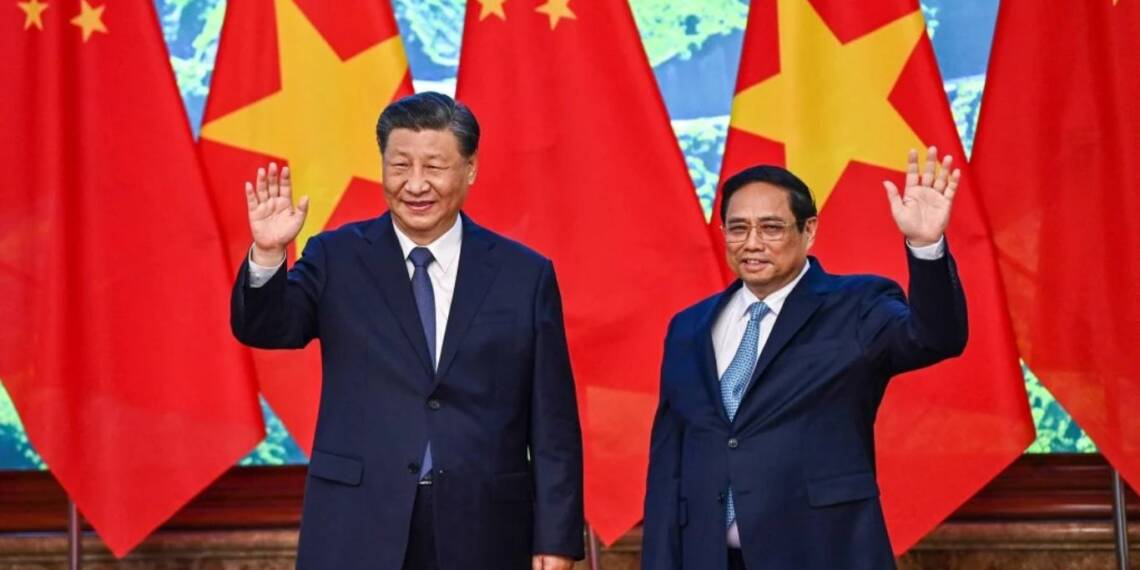The Pressient of China Xi Jinping has now asked Vietnam to stand against the “unilateral bullying” to support free and open trade. Xi is now on a key diplomatic trip to export-driven countries, trying to showcase China as a steady and trustworthy partner, unlike the United States as the trade war rumbles on.
Xi is visiting Southeast Asian countries this week. He reached Vietnam on Monday. Soon he will visit Malaysia and Cambodia from Tuesday to Friday. These countries have grown closer to China in trade and investment.
During talks with Vietnam’s top leaders, Xi said both countries should work together to keep global trade and supply chains stable, according to China’s state news agency Xinhua.
Xi said China’s big market is always open for Vietnam. He also claimed that both nations must stay focused and stand together against any “unilateral bullying.”
He used an example and said, “A small boat with one sail cannot survive strong waves, but working together can help us sail safely and far.”
Xi’s trip comes a few days after US President Donald Trump paused his “reciprocal” tariffs on most countries for 90 days. Now, Trump’s trade war is primarily targeting China.
As China and the US increase tariffs on each other, Southeast Asian countries feel worried. They don’t want to get stuck between the world’s two largest economies.
Xi wants to use the trade tension to show China as a stable friend and defender of global trade. Vietnam and Cambodia were hit hard by Trump’s tariffs, which were 46% and 49% before the pause.
Even though these countries are welcoming Xi warmly, experts say they must be careful. If they seem too close to China, they might upset Trump, who is still negotiating tariffs with them.
On Monday, Trump told reporters that Xi’s meeting with Vietnam’s president, To Lam, was meant to harm the US. He added, “I don’t blame China or Vietnam. It’s a nice meeting. They are trying to figure out: ‘How do we cheat the United States?’” Trump also said the European Union was created to harm the US.
China’s top export market
Some Southeast Asian countries fear their markets will be flooded with cheap Chinese goods, which can’t go to the US because of tariffs. China already sells much more to Vietnam than it buys.
Since 2023, the ASEAN group has become China’s biggest export market, passing both the US and EU.
Vietnam, which has grown as a manufacturing hub, has received more Chinese investment. Many companies are moving factories to Vietnam to save costs and avoid US tariffs. China’s trade with Vietnam almost doubled from 2017 to 2024, making Vietnam its top trade partner in Southeast Asia.
During this visit, Xi is expected to strengthen the partnership further. Vietnam’s Deputy Prime Minister Bui Thanh Son said both countries will sign about 40 deals in many sectors, such as railways, farming trade, and digital and green economy.
Vietnam has also approved a plan to build an $8.3 billion railway from Haiphong port to China, partly funded by Chinese loans. Vietnam also wants to buy Chinese-made passenger planes from COMAC.
Wen-ti Sung, an expert from the Atlantic Council, said Xi’s visit has two goals. One is to grow China’s economic ties around the world. The other is to pull these countries closer to China while they feel uncertain because of Trump’s changing tariff moves.
Sung said, “Xi is visiting in person to show care, not fear. He might also bring some gifts, like new trade deals or partnership upgrades.”
“All of this is to show that China is your friend. You can trust China, especially if you are worried about the US.”
However, China and its neighbours have had tensions, especially over disputed areas in the South China Sea. In February, China held live-fire navy drills near Vietnam after Vietnam shared a new map claiming its territories there.
Xi wrote that the way both sides settled land and Beibu Gulf border disputes shows they can also solve sea issues through talks and peaceful negotiations.
For China, the coming months are crucial, as China wants to keep its neighbours and extended neighbours alongside in the fast evolving trade war.








